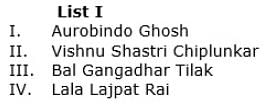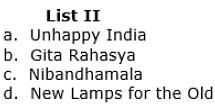MH SET Paper 2 Mock Test - 4 (History) - MAHA TET MCQ
30 Questions MCQ Test MH SET Mock Test Series 2025 - MH SET Paper 2 Mock Test - 4 (History)
Who among the following used 'Comparative and Historical Research Method' in their study?
Who observed that "Just as Darwin discovered the law of development of organic nature, so Marx discovered the law of of development of human history"?
Which of the following Gupta kings had issued a gold coin which depicts a rhinoceros?
Match the following, with reference to the Mauryan dynasty.

Arrange the following events of Jahangir's reign in the chronological order.
(i) Revolt of Mahabat Khan
(ii) Khurram was Viceroy of the Deccan
(iii) Captain Hawkins visit to his court
(iv) Sir Thomas Roe's arrival at Jahangir's court
Choose the correct answer from the following codes :
The Vernacular Press Act in British India was concerned with-:
Consider the following statements related to the Revolt of 1857:
- The administrative policy of the east India Company underwent frequent changes during the long period between 1757- 1857, however, it never lost sight of its main objects which were to increase the Company’s profit.
- However, they did not focus much on the law and order in the country which ultimately caused the revolt of 1857.
Which of he statements given above is/are correct?
Consider statements A, B and C and choose the correct option.
(A) The palaeolithic period extends from 2 million years ago to about 12,000 years ago.
(B) This long stretch of time is divided into the lower, middle and upper palaeolithic.
(C) This long span of time covers 99% of human history.
Which aspect of the INA's formation and operations demonstrates the complexity of international alliances during World War II?
Which of the following statement(s) is/are TRUE?
A. Harishena composed a Prashasti in praise of Gautamiputra Shri Satakarni.
B. The rulers of Aryavarta brought tribute for Samudragupta.
C. There were twelve rulers in Dakshinapatha
D. Aihole was the capital of the Pallavas.
Which is the correct chronology of following events occurring during the reign of Akbar?
a. Declaration of Mazhar (Infallibility decree)
b. Abolition of zazia
c. Declaration of Tohid-i-Ilahi
d. Construction of Ibadatkhana
Choose the correct combination given below:
Consider the given statements.
I. Harshavardhana was converted into Hinayana Buddhism by the Chinese Buddhist traveler Huan tsang.
II. He also conducted the Buddhist conferences called Sangeethis at Prayag.
III. Harshavardhana was defeated by Pulakesin I in the battle of Narmada.
Choose the correct statement/statements.
Consider the following statements
Some of the main features of the Government of India Act, 1935 were the
- abolition of diarchy in the Governor’s provinces.
- power of the Governors to veto legislative action and to legislate on their own.
- abolition of the principle of communal representation.
Which of the statement(s) given above is/are correct ?
With reference to the rise of Bengal, consider the following statements:
1. Bengal was the most fertile and the richest province of the Mughal Empire and included present-day Bangladesh and the states of Bihar and Odisha.
2. Bengal held economic importance for its famous textiles, silk, and saltpeter.
3. Exports from Bengal to Europe consisted of saltpeter, rice, indigo, pepper, sugar, silk, cotton textiles, handicrafts, etc.
Which of the above statement is/are correct?
Choose the correct statements.
1) In 1858 Lord Canning sent forth the royal proclamation in a grand Darbar at Delhi.
2) It was then proclaimed that all treaties and engagements of East India Company with princely states would be maintained and honoured.
3) The document was called “Magnacarta of the People of India”.
Choose the correct pair, with reference to the Jaina Council.
- First Council:- resulted in the compilation of 14 Purvas.
- Second Council:- resulted in final compilation of 12 Angas and 12 Upangas.
Consider the following statements, with reference to the Harrapan Civilization.
- The Harappan society seems to have been divided into two sections, viz. an elite class, associated with the Citadel and the rest of the society occupying the lower town.
- Doorways and windows mostly opened out into the main street.
- There is no system of street drainage at Kalibangan.
- The lower town was not walled.
Choose the incorrect statement.
Who wrote the book—‘The Story of The Integration of The Indian States’?
|
60 tests
|


























